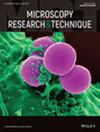Photoactivated riboflavin-doped hydroxy apatite nanospheres infiltered in orthodontic adhesives
Abstract
To assess micro-tensile bond strength (μTBS), degree of conversion (DC), microleakage (ML) antibacterial efficacy, and adhesive remnant index (ARI) of orthodontic brackets to enamel with different concentrations of photoactivated riboflavin-doped hydroxyapatite (HA) nanospheres (NS) (0%,1%,5% and 10%) and 0.5 wt% RF alone in orthodontic adhesive. Samples were included on the predefined inclusion criteria and positioned up to the cementoenamel junction (CEJ). Hydroxy apatite nanospheres (HANS) commercially bought were doped with RF. Surface characterization of HANS and RF-doped HANS were assessed along with EDX analysis. Samples were grouped based on experimental orthodontic adhesive modification. Group 1: Transbond XT no modification, Group 2: experimental Transbond XT 0.5 wt% RF, Group 3: experimental Transbond XT 0.5 wt% RF-doped 1% HANS, Group 4: experimental Transbond XT 0.5 wt % RF-doped 5% HANS and Group 5: Experimental Transbond XT 0.5 wt% RF-doped 10% HANS. Brackets were placed based on different adhesive modifications and samples underwent thermocycling. Samples were evaluated for μTBS, DC, and ML. The type of failure was assessed using ARI. Adhesive modified and un-modified in four different concentrations (0%, 1%, 5%, and 10%) and 0.5 wt% RF only were used to test efficacy against Streptococcus mutans (S.mutans). The survival rate of S.mutans and ML was determined using the Kruskal–Wallis Test. For the analysis of μTBS, ANOVA was employed, followed by a post-hoc Tukey HSD multiple comparisons test. The highest μTBS and lowest ML were observed in Group 2 experimental Transbond XT 0.5 wt% RF only. The lowest μTBS, highest ML, and lowest DC was seen in Group 5 experimental Transbond XT 0.5 wt% RF-doped 10% HANS. Samples in Group 1 in which Transbond XT was used as adhesive demonstrated significantly the highest microbial count of S.mutans and DC. Photoactivated RF-doped HANS in 1% and 0.5 wt% Riboflavin alone in orthodontic adhesive for metallic bracket bonding improved micro tensile bond strength, ML, DC, and antibacterial scores.
Research Highlights
- The highest μTBS and lowest ML were observed in Group 2 experimental Transbond XT 0.5 wt% RF only.
- The lowest μTBS, highest ML, and lowest DC was seen in Group 5 experimental Transbond XT 0.5 wt% RF-doped 10% HA-NS.
- Samples in Group 1 in which Transbond XT was used as adhesive demonstrated significantly the highest microbial count of S.mutans and DC

 求助内容:
求助内容: 应助结果提醒方式:
应助结果提醒方式:


